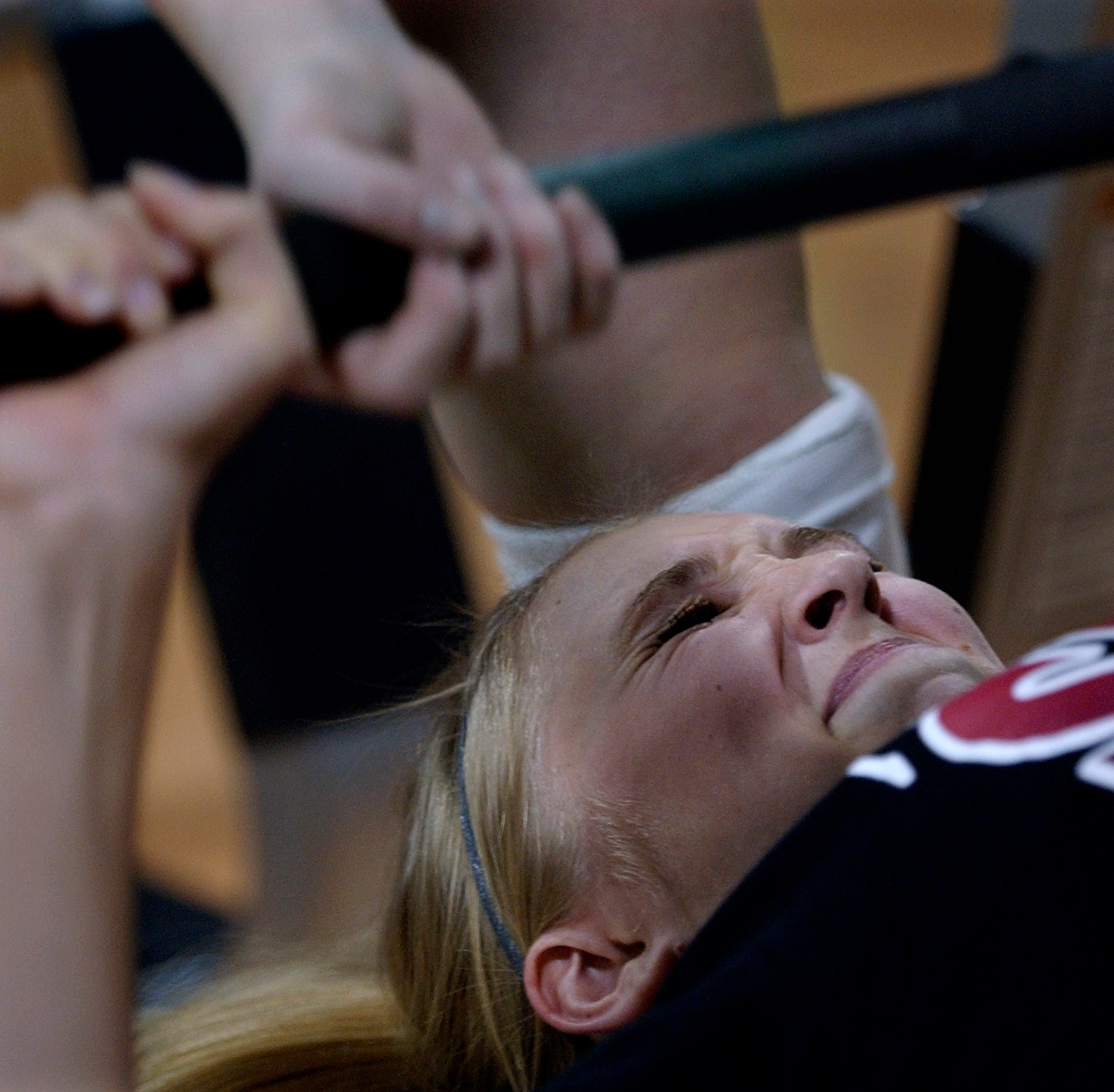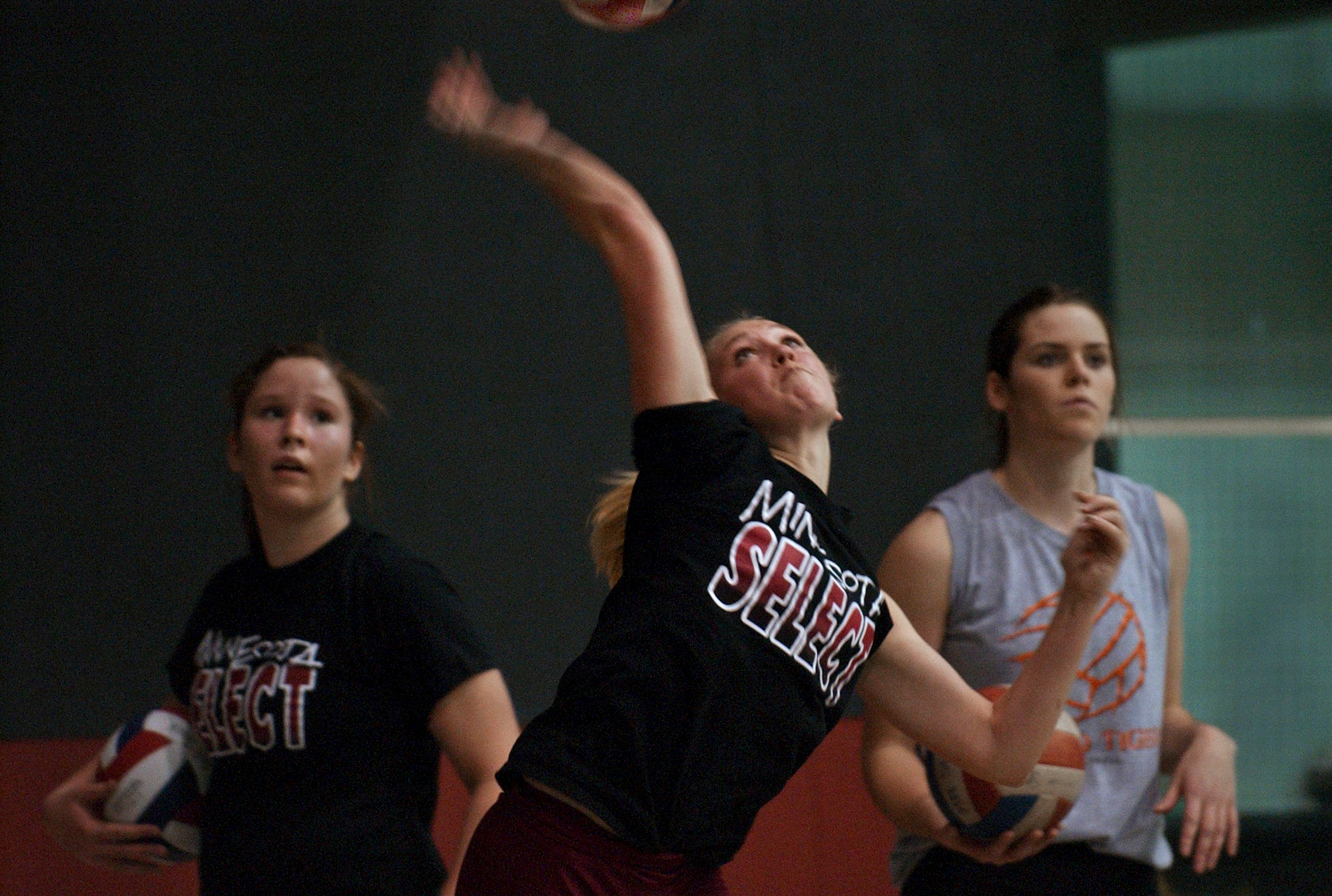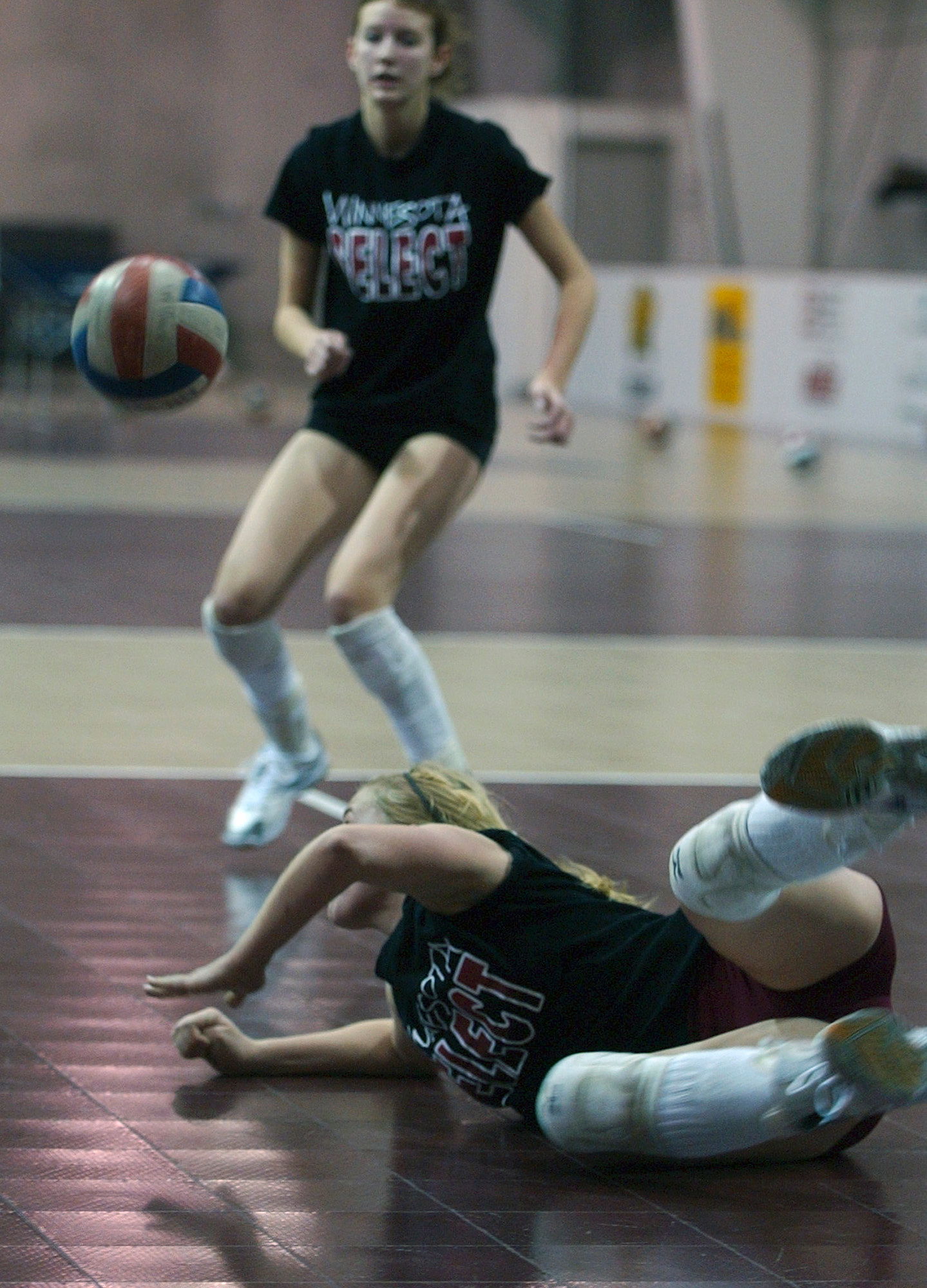Credit: Joey McLeister, Star Tribune
When the right knee isn't tender and sore, it's stiff and achy. But Katelyn Riddersen can't bring herself to stop playing.
The Totino-Grace High School junior plays volleyball year-round despite a knee that has been severely injured since last winter.
"My doctor told me what I could do to fix it -- that was take four months off because I'm overworking it," Riddersen said. "I said no way. I couldn't do it. That meant I would fall behind, and I didn't want to."
Others -- many others -- feel her pain.
Coaches, orthopedists and athletic trainers say overuse injuries, once the curse of the 40-and-over set, are plaguing growing numbers of athletes in their teens and even younger. Many blame an ever more intense youth sports culture that's pushing kids to compete harder and at much earlier ages.
"It's alarming," said Dr. Anthony Stans, a pediatric orthopedic surgeon at the Mayo Clinic in Rochester.
"We used to see these injuries more in the 15-to-18-year-old range," Stans said. "Now, we're seeing it in kids as young as 8 or 9."
In 2003, more than 3.5 million children younger than 15 required medical treatment for sports injuries, according to the U.S. Consumer Product Safety Commission.
That number has more than quadrupled since 1995, when it was 775,000.
Minnesota follows trend
Locally, the number of injuries also has spiked. Stans estimated that he has seen overuse injuries among kids double in the past five to 10 years.
A Blue Cross and Blue Shield survey released last fall found that four of every 10 Minnesota families with children in organized sports have a child who has suffered an injury requiring medical treatment. Of those treated, one-third missed school.
Most of the treated injuries stem from doing too much too soon. The repercussions of that can be devastating -- sometimes causing permanent damage. In Minnesota, one in 10 parents cited injury as the reason their child quit a sport.
The explosion of sports injuries is also pushing up the cost of medical care.
"The treatments are definitely better than they were years ago, but they're also expensive," said Keith Folkert, a medical director at Blue Cross and Blue Shield, a nonprofit health insurance company.
Injuries ranging from pulled muscles to torn ligaments to stress fractures are showing up in gyms and training rooms around the Twin Cities.
Credit: Joey McLeister, Star Tribune
At Benilde-St. Margaret's, more boys' soccer players are limping to preseason practices with injuries, according to coach Dave Platt. "I had a kid with a hip flexor injury who didn't have enough time to rest it," he said. "One student had an ankle injury who could have used more rest."
BSM, a Catholic school in St. Louis Park, has one of the state's top small-school soccer programs.
At Elk River, a handful of boys' hockey players have played injured for an entire calendar year. The same goes for boys' soccer players at Park Center. "These kids' seasons aren't ending," lamented Rob Loftus, who coaches both teams, as an assistant coach at Elk River and head coach at Park Center. "They're just not getting any time to rest."
Athletes at Totino-Grace purposely avoid doctors, knowing many will tell them to rest. "They don't want to hear that," said Dave Matzoll, the school's athletic trainer. "They want to know: `What can I do to keep playing?'"
At White Bear Lake, longtime athletic trainer Joel Kaden has noticed a definite increase in chronic overuse injuries. "Has it gotten to be catastrophic? Probably not yet," he said. "But if the trend keeps going, five or 10 years from now you'll see it getting real bad."
Overdoing it from a young age
Too much volume, intensity and frequency add up to an overuse injury. Among the young, the injuries include stress fractures caused by inadequate recovery; growth plate injuries, which can lead to permanent damage, and soft-tissue damage to tendons, muscles and ligaments.
Most of these ailments are preventable.
Children are pressured into starting club sports early and specializing in a single sport. Some players on traveling teams are as young as third- and fourth-graders. The three-sport athlete is becoming obsolete, especially at bigger schools.
Kaden, an athletic trainer for more than two decades, knows of 6- and 7-year-olds who have already chosen to play only one sport.
"How can you give up at that age?" he said. "Some of your best athletes don't blossom till 14, 15, 16 years old."
Club and traveling teams have proliferated, causing seasons to overlap one another.
"I have neighbors who go to hockey camp every day of the week for three hours a day," Eagan volleyball coach Kathy Gillen-Melville said. "One is in fourth grade, and the other in seventh. That is insane. It bothers me."
Coaches and doctors say club teams are asking kids to cram more games into longer seasons.
They talk of volleyball clubs beginning practices barely a week after the high school season ends and of soccer clubs that have held tryouts the same week that high schools hold theirs.
"Professional athletes take three to four months [off] after the season; they have that down time," said Mark Obarski, girls' soccer coach at Eagan. "But the kids, it seems like they go from one thing to the next thing to the next thing. Their bodies never have time to recover."
Playing with pain
Riddersen plays volleyball year-round: for Totino-Grace, a Catholic high school in Fridley; her Minnesota Select club team, or a beach volleyball team during the summer.
About a year ago, Riddersen's right knee started bothering her. By February, it began to buckle.
A doctor told Riddersen her patellar tendon was shredding. But instead of taking time off, as he recommended, she kept playing. "I just taped my kneecap up so it had more support," Riddersen said. She played on her club team and didn't miss a high school match.
Cindy Riddersen, Katelyn's mother, says it's difficult to watch her daughter play in pain. But she doesn't tell her to stop because she knows how much volleyball means to Katelyn.
"It's her entertainment and her social life," Cindy Riddersen said, "so [Katelyn] doesn't rest [the knee] at all. There's nights where it's swollen, where she should ice but she doesn't ice. Kids at this age think they're invincible."
Pressure starts early
Some kids opt to specialize -- and resist taking time off -- to earn a scholarship. But often it's others who drive the one-sport
trend.
Loftus said he didn't realize parental pressure could begin so early until he signed up his son for hockey two years ago.
"It's like a mini-camp for parents to groom 6-year-olds to be high school players," he said.
Dr. Daniel Buss, a Minneapolis orthopedic surgeon and team physician for the Minnesota Twins, has had young patients admit they overdo it to please their parents. Often, when he tells a youngster to take a month off from baseball, football or tennis, "the dad doesn't want to hear that," he said.
Coaches also can play a role in specialization. Stans, of the Mayo Clinic, said he's treated kids who were told they wouldn't
play basketball in high school unless they played year-round in junior high.
"The kids aren't asking for it," he said. "I'm not seeing kids come in and say, `Gosh, I wish I could play soccer 12 months of the year, six nights a week, three hours a night.'"
Kids are especially susceptible to overuse injuries, since their bones, muscles and tendons are still developing. Running and
jumping too much can cause stress fractures in ankles and shins. Serving a tennis ball or throwing a baseball too many times can lead to rotator cuff injuries or elbow stress fractures.
Some orthopedists believe overuse might also play a role in the recent explosion in knee injuries, especially among girls.
Often a little ice and rest are enough to heal nagging overuse injuries. But with others, such as tennis elbow, Achilles'
tendinitis and shin splits, the damage can be permanent - boosting the likelihood of chronic pain, osteoarthritis and the need for surgery later in life.
The effects of overuse injuries "can be devastating," said Dr. Carl Nissen, an orthopedic surgeon at the University of Connecticut who has studied the causes of such injuries among adolescents. "They can potentially have permanent effects through life. It can happen to the kid who was the star at age 13, but at 18 is out. They've closed the door, reduced their options."
Nissen, who preaches against specialization, admits he has trouble persuading his own high school-age kids to play more than one sport - but he does make sure they schedule a yearly break.
His basketball-playing daughter doesn't touch a ball for six weeks over the summer. Instead, she spends the time working on
strength, agility and speed.
At the same time that obesity among the young is burgeoning, it's paradoxical that more and more kids are getting hurt because they do too much.
"We want to get kids active and maintain healthy weight," Stans said, "and we've got another group of kids who are stressed out and having overuse injuries because they're constantly playing. There's nothing in the middle for kids who just want to enjoy being outside, participating."
More injuries
U.S. children under 15 requiring medical treatment for sports injuries:
- 1995: 775,000
- 2003: 3.5 million
Source: Blue Cross and Blue Shield
Preventing overuse injuries
The American College of Sports Medicine estimates that 50 percent of overuse injuries in youngsters can be prevented. Although there is no magic remedy, doctors and athletic trainers have these tips:
- Coaches should look for slowing times or subtle changes in mechanics, and take them seriously. The earlier injuries are caught, the more quickly they will heal.
- Coaches and athletes should become more comfortable talking about pain and backing off earlier. "Kids won't hurt themselves if you leave it up to them," said Dr. Bill Roberts, an associate professor at the University of Minnesota who has treated hundreds of young athletes. "But if there's external pressure from parents, coaches and schools, you can override that natural ability to say enough is enough."
- Coaches should treat kids individually.
- Work on specific skills, rather than the same thing repeatedly.
- Kids should take a month or more off every year to give muscles and bones a break.
- Play a variety of sports. Or cross train to prevent one area from becoming overworked.
- Limit the nights of practice per week.
- Provide more options to participate in less competitive, mid-level sports.
Online resources
Here are four websites to check out for more information on how youngsters and teens can avoid sports injuries:
Blue Cross and Blue Shield of Minnesota offers tips for avoiding childhood sports injuries
www.startribune.com/a825
Childhood Sports Injuries and Their Prevention. A Guide for Parents with Ideas for Kids. National Institute of Arthritis and Musculo-skeletal and Skin Diseases
www.startribune.com/a826
Minimizing the Risk of Injury in High School Athletes
www.startribune.com/a827
National Youth Sports Safety Foundation
www.nyssf.org
Kids and sports injuries
Six of the most common overuse injuries, according to experts:
Swimmer's shoulder: Painful shoulder impingement commonly associated with swimming freestyle.
Tennis elbow: Covers any overuse injury to elbow bone or cartilage. Affects tennis players and young pitchers who throw too much.
Knee damage: Syndrome typified by tugging of muscle under the kneecap, causing pain and quadriceps fatigue. Common in nearly all sports, especially among females.
Shin splints: Pain over the front of the tibia bone caused by damaged muscles, bones or ligaments. Commonly seen in athletes who suddenly increase their duration or intensity of training. Can afflict volleyball, basketball, soccer players and runners.
Tendinitis: Inflammation in the Achilles tendon, in the back of the ankle. Can lead to small tears within the tendon, making it susceptible to rupture. Common in youngsters who play running sports, including basketball and soccer.
Stress fractures: A pain or crack in the bones, commonly seen in athletes who run and jump on hard surfaces such as basketball players and runners. Often seen in the foot and shin bones.
Sidebar: Injuries take a toll on Brett Peterson year after year
After four years of nags and pains, Brett Peterson believes he's finally injury-free -- or as close as he'll get to it. "Both of my
shoulders have been bad," the 6-2 senior winger from Elk River said.
Peterson separated his left clavicle four years ago in a bantam game. Even today, the clavicle is 3 millimeters out of place, and his doctor says it will probably remain that way. "It's a nagging injury," he said. "But you can play with it. It won't get any worse."
Peterson's right shoulder also has been ailing. He bruised it last fall checking an opponent during a Minnesota Elite League
game. It was a stinger, something "you just play through." He sat out only one game.
Since then, Peterson has bruised the shoulder over and over. "But that's hockey," he said, "part of the strain of the game. I just play with it." He also stretched the medial collateral ligament in his knee two weeks ago, missing two games before returning.
Peterson, who is being recruited by the Gophers and Colorado State, began hockey in kindergarten and has played year-round since fourth grade. During the spring, he plays baseball for the Elks.
"This kid has been through the gamut of injuries," said Rob Loftus, an assistant hockey coach at Elk River. "He's a big, strong
tough kid. I think this year he'll finally be healthy."
Sidebar: Katie Graeve has second thoughts after 2 torn ACLs
On the first day of soccer tryouts two falls ago, Katie Graeve's junior season came to a sudden end. "I got hit from the side, I
fell and I felt pain," the standout player from Eagan recalled. "I played a little more, thinking it was OK, and I tried to run for
the ball and fell again."
Graeve, who had started on defense as a freshman and sophomore, soon learned that she had torn her right anterior cruciate ligament, a tough band of tissue that stabilizes the knee by connecting the thigh to the shin. The debilitating injury requires surgery and months of rehabilitation -- which Graeve underwent diligently.
Nearly six months after getting hurt, Graeve returned to the field in the summer.
But on Aug. 27, two games into her senior season, she ran for the ball, planted her foot wrong and immediately knew she had torn the ACL in her other knee, ending her high school career.
"I was pretty much devastated," she said.
Knee injuries strike young athletes with alarming frequency -- especially females, who are far more likely to suffer the injury than males, according to several studies. The majority of ACL tears occur in females ages 15 and 25, according to the American Academy of Orthopaedic Surgeons. Those playing sports involving jumping, pivoting, and sudden stops and starts are especially vulnerable.
A Blue Cross and Blue Shield survey found that, between 2003 and 2004, the number of knee repairs in a single year jumped 5.8 percent among Minnesota teenage girls and 2.4 percent among boys.
Graeve has learned that her ACL tears might have been preventable.
"Doctors think my injury may be the case because I only play one sport," she said. "I don't work all the muscles."
Graeve has played soccer year-round since her freshman year when she quit basketball. Her only time off from the sport came during the month between her summer premier league and the start of the high school season, plus a couple of weeks in November.
Dr. Elizabeth Arendt, an Minneapolis orthopedic surgeon who has studied ACL tears for more than a decade, said the dominance of one muscle group over another can increase the risk for the injury. Strengthening all of the muscles around the knee can help reduce the risk.
"Some say we're too quad-dominant," she said. "It's not a strength issue, but more of a symmetry in strength patterns."
Graeve, who hopes to return to her premier team by March, says she might have done things differently if she knew then what she does now.
"I probably would have worked harder to keep my muscles strong," she said. "And I probably would have stuck with another sport."









